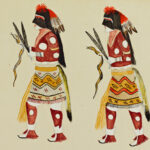Kompa Dance, a vibrant expression of Caribbean culture, often resonates with rhythms that have deep connections to other musical forms in the region. While frequently associated with Haitian Kompas, its story is intertwined with other Caribbean sounds, including cadence-lypso. To truly appreciate Kompa dance, it’s insightful to explore these connections, particularly the role of cadence-lypso and artists who bridged these musical worlds.
Cadence-lypso, a genre originating from Dominica, holds a significant place in Caribbean music history. Webert Sicot, a highly regarded musician known for his virtuosity and harmonic skills, is often credited as the originator of a style of cadence that gained immense popularity throughout the Caribbean. In Dominica, “cadence” became a more common term than “compas,” highlighting the distinct flavor of their musical expression. Cadence-lypso, sometimes referred to as Dominican kadans, became one of the two dominant music styles in Dominica alongside calypso, hence its hyphenated name. Many songs from this era were categorized as either calypso, reggae, or primarily cadence or compas. Fusions existed, but they were subtle, with album covers primarily highlighting “cadence,” “calypso,” and “reggae.”
Looking back at album covers from bands like Grammacks and Exile One, the emphasis on “cadence” is clear. Grammacks, for example, listed “kadans” alongside song titles like “Mediba,” “Banana,” and “Ou Pa Bon.” Exile One, another leading group, also prominently featured “cadence-lypso.” Their album “Exile One – Gordon Henderson 40 Volume 1” exemplifies this, showcasing 14 kadans tracks out of 18, alongside calypso and reggae influences. Songs like “Rosita,” “Ba Yo Boi,” and “Aki Yaka” are examples of their kadans sound, while tracks like “Jamais Voir Ca” and “Ilyne” represent their calypso side. Even the song titled “Cadence Lypso” on this album is identified as a kadans tune, underscoring the close relationship between the terms in Dominica. Another compilation, “Collector Kadance Lypso,” further cemented this association, featuring méringue cadence tunes from Exile One and other bands like Midnight Groover and Liquid Ice.
While it might be speculated whether these bands intentionally fused Trinidadian calypso with Haitian cadence or compas, the fusion, if any, remained understated. Tracks like “La Dominique” from Exile One’s “Old School Session” album might hint at such experimentation, but their core repertoire remained deeply rooted in cadence or compas styles. Their album “Exile One-Old school Session: Gree/Vert” predominantly featured méringue cadence or compas, with six out of eight tracks falling under this category, including songs like “Fete Commune” and “Sylvie.” Exile One, led by Gordon Henderson, was a pioneering kadans band, notably being among the first to incorporate synthesizers into their music in the early 1970s. This innovation was soon adopted by other young cadence or compas bands from Haiti (mini-jazz) and the French Antilles, influencing the evolution of Caribbean music.
Exile One’s impact extended far beyond Dominica, as they toured extensively, bringing kadans music to diverse audiences in Japan, Africa, Europe, and North America. Other Dominican cadence bands, such as Grammacks, alongside artists like Bill Thomas and Ophelia Marie, further contributed to the popularity of this genre. Exploring the discographies of these artists and bands, readily available on platforms like Amazon Music, reveals the rich tapestry of cadence and its connection to the broader Caribbean musical landscape that informs and enriches the experience of Kompa dance today. The legacy of cadence-lypso and its pioneers provides valuable context for understanding the rhythmic foundations that continue to inspire dancers and musicians within the Kompa dance scene and beyond.

